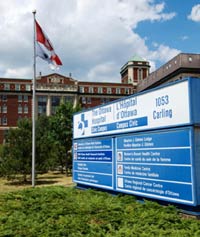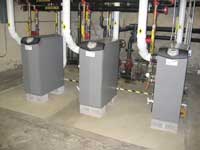view all Case Studies
HVAC, Lighting Retrofits Help Hospital Conserve Energy, Money

The Ottawa Hospital is one of the largest and most respected healthcare organizations in Canada. Formed in 1998 by a merger between two academic hospitals and two community hospitals, the hospital accounts for about 4 million square feet of real estate across three campuses
June 6, 2008 -
Energy Efficiency
The Ottawa Hospital is one of the largest and most respected healthcare organizations in Canada. Formed in 1998 by a merger between two academic hospitals and two community hospitals, the hospital accounts for about 4 million square feet of real estate across three campuses.
After working its way through a difficult financial period in the late 1990s, the hospital looked to sustain its fiscal strength. The hospital identified two areas – energy costs and facilities infrastructure – where it could be more efficient and drive additional funds into patient care.
The hospital understood it needed to take action to reduce costs and improve building performance. The hospital conducted several internal audits in 2002 to identify energy-saving opportunities and other areas where it could improve productivity.
“Many of the conservation suggestions, such as turning off lights at night in unoccupied areas of the facility, came from the hospital staff,” says Brock Marshall, the hospital’s director of engineering. “All of the ideas were taken into consideration and ranked by order of magnitude of savings they would deliver.”
Honeywell had a 25-year service-and-maintenance relationship with the organization and recommended an energy-savings performance contract, offering a solution that would deliver energy-efficiency upgrades and more operating dollars though a self-funded program. The $17-million, 15-year performance contract with Honeywell guaranteed the hospital would save more than $2.6 million annually in utility costs.
The hospital chose the Honeywell program, and the company began installing energy-conservation measures in the summer of 2004. The implementation plan included:
*installing an enterprise buildings integrator (EBI) automation platform, which covers about 5,500 points of control for all three campuses
*replacing several chillers with more energy-efficient and environmentally responsible models that do not use chlorofluorocarbons (CFC).
*retrofitting more than 45,000 light fixtures across all three campuses
*upgrading lighting at two parking garages
*installing high-efficiency hot water and heating boilers
*replacing existing motors and adding variable-frequency drives
*implementing power-factor correction systems
*improving building envelopes to reduce drafts and prevent energy leaks
*installing water-conserving fixtures and reducing process-water usage
*implementing an ongoing awareness program to educate staff and the community.
The EBI allowed managers to see an integrated view of a campus’ HVAC system and optimize operations depending on variables such as temperature or time of day. In many cases, it helped managers identify a problem before building occupants realized an issue existed.
Replacing chillers on one of the campuses also created significant benefits, as the hospital upgraded to environmentally responsible, CFC-free units and operated them more efficiently as a result of the EBI.
“We’re able to see the operation of every fan, every pump, and every major building operating system and immediately determine how they are performing,” Marshall says.
Since the hospital implemented the efficiency and conservation program, it has reduced natural-gas consumption by 40 percent, electricity by 18 percent, steam by 23 percent and water by 5 percent. These reductions have curbed carbon dioxide emissions by nearly 12,000 tons annually, which has the same environmental impact as planting more than 39,000 trees or removing 2,300 cars from the road.
The lighting retrofits resulted in the recycling of fluorescent tubes and magnetic ballasts, totaling 9.8 tons of glass, 123 kilograms (kg) of aluminum, 154 kg of phosphor, and 1.02 kg of mercury.
“This project has allowed us to become far more environmentally friendly and create a building platform to identify further initiatives in the future that will achieve further building and environmental efficiencies,” says Cameron Love, the hospital’s vice president of facilities, planning and support services. “Because of our success in this area, we’ve been fortunate enough to receive awards and grants from various organizations in Canada.”
Next
Read next on FacilitiesNet












